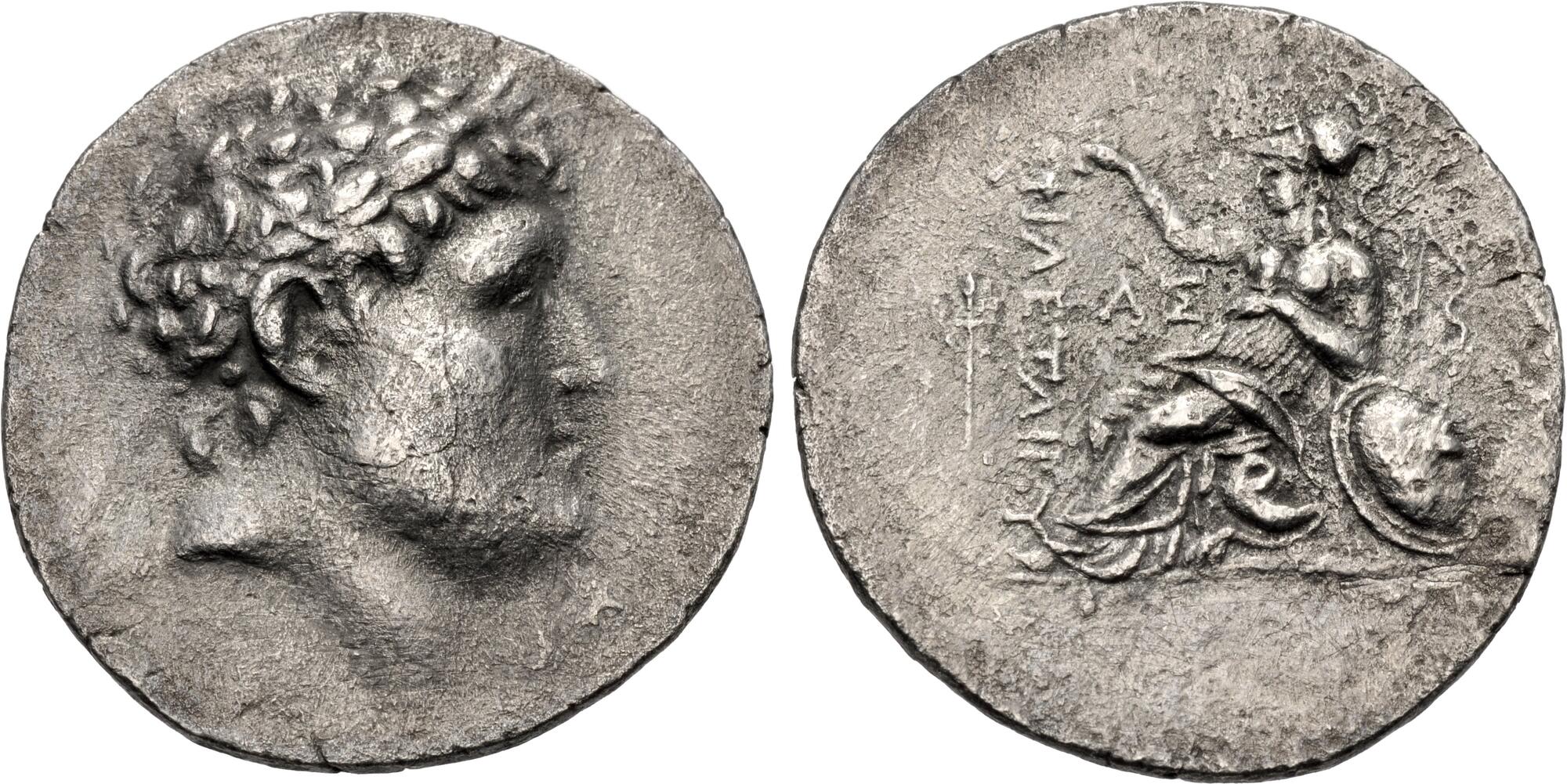Pergamum (Eumenes II), silver, tetradrachms (197-190 BCE)
From SILVER
197 BCE - 190 BCE Silver 15,214 kg
Description
| ObverseInscription or printing placed on the obverse.: | Laureate head of Philetairos right. |
| ReverseInscription or printing placed on the reverse.: | ΦΙΛΕΤΑΙPΟY (Greek).Athena enthroned left, resting on shield to right, crowning dynastic name to left, transverse spear in background, filleted thyrsos to outer left, AΣ to inner left, bow to right. |
Mint and issuing power
| MintIdentifies the place of manufacture or issue of a numismatic object.: | Pergamum | Ancient regionAncient region.: | Mysia | Modern countryModern country: Turkey | AuthorityIdentifies the issuing power. The authority can be "pretended" when the name or the portrait of X is on the coin but he/she was not the issuing power. It can also be "uncertain" when there is no mention of X on the coin but he/she was the issuing power according to the historical sources: | Attalid Kingdom, Eumenes II of Pergamum (Attalid king, 197-159 BC) |
Chronology
| FromIdentifies the initial date in a range assigned in a numismatic context. | 197 BCE | toIdentifies the final date in a range assigned in a numismatic context.. | 190 BCE | PeriodTime period of the numismatic object.: Hellenistic 323-30 BC |
Physical description
| MetalThe physical material (usually metal) from which an object is made.: | Silver |
Median weightMedian of the weights of numismatic objects (in grams). in grams | 16.80 | DenominationTerm indicating the value of a numismatic object. Examples: tetradrachm, chalkous, denarius.: | tetradrachm |
StandardStandard.: | Attic |
Image

H 210 Eumenes II tetradrachm.jpeg [1]
References
| Die study referencePublication of the study: | Westermark 19601Westermark 1960 | ||
| Coin series referenceReference to coin series study: | Sear II2Sear II, n° 7225-7226, RQEMH3RQEMH, n° 210 | ||
Obverse dies distribution
| FrequencyFrequency of specimen in distribution. ᵖ | Number of obversesNumber of obverse dies. ᵖ (o) | % (o) | Number of coinsNumber of coins. (n) | % (n) | Die nameName(s) of the die(s). |
| 1 | 15 | 62.5 | 15 | 35.71 | 131, 132, 134, 135, 138, 139, 140, 141, 142, 144, 149, 150, 151, 153, 154 |
| 2 | 5 | 20.83 | 10 | 23.81 | 133, 136, 143, 145, 152 |
| 3 | 1 | 4.17 | 3 | 7.14 | 137 |
| 4 | 1 | 4.17 | 4 | 9.52 | 147 |
| 5 | 2 | 8.33 | 10 | 23.81 | 146, 148 |
| Total | 24 of 24 | 100 | 42 of 42 | 99.99 |
Reverse dies distribution
no distribution is available
Quantification
| Number of obversesNumber of obverse dies. ᵖ (o) | 24 | Number of singletons (o1)The number of singleton coins. ᵖ | 15 |
| Number of reverse diesNumber of reverse dies. (r) | 40 | Number of coinsNumber of coins. (n) | 42 |
| Coins per obverse dieNumber of coins per obverse die. (n/o) | 1.75 | Coins per reverse dieNumber of coins per reverse die. (n/r) | 1.05 |
| Reverse per obverse ratioRatio of obverse dies divided by reverse dies. (r/o) | 1.67 | Percentage of singletons (o1)number of coins (n) divided by the number of singletons (o1) ᵖ | 62.5 % |
| Original number of dies (O) (Carter 1983 formula)The estimation of the number of coins according to Carter 1983 ᵖ | 45.28 | Coins struck if 20,000 as average productivity per dieCoins made if the average productivity for obverses (according to Carter) is 20,000. ᵖ | 905,600 |
| Original number of dies (O) (Esty 2011 formula)The estimation of the number of coins according to the singleton formula in Esty 2011 ᵖ (O) | 56 | Survival rate if 20,000 as average productivity per dieSurvival rate if average productivity is 20,000. ᵖ | 0.00005 |
| Coverage (o = % of O) (Esty 1984 formula)Esty 1984 - coverage (% of O) ᵖ (o = % of O) | 64.29% | Die productivity if survival rate 1/2,000Average productivity if survival rate is 1/2,000. ᵖ | 1,855.12 |
| Weight of silver (in kg) if 20,000 coins per die (O = Carter formula)Carter 1983 * Median weight * 20000 (*10 if gold or electrum) ᵖ | 15,214 kg <br /> 15,214 kg | Die productivity if survival rate 1/5,000Average productivity if survival rate is 1/5,000. ᵖ | 4,637.81 |
Remarks
Most likely one single workstation
References
- ^ Westermark, Ulla (1960), Das Bildnis des Philetairos von Pergamon. Corpus der Münzprägung, Stockholm.
- ^ Sear, David R. (1979), Greek coins and their values. Vol. II, Asia and North Africa, London, xlviii, p. 317-762
- ^ Callataÿ, François de (1997), Recueil quantitatif des émissions monétaires hellénistiques, Numismatique Romaine, Wetteren, X + 341 p.